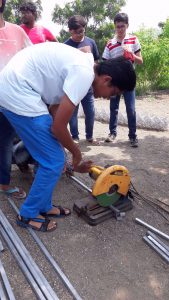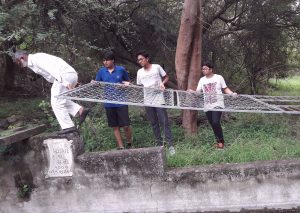We went to a village in Saurashtra, Gujarat called Savarkundla for our CAS trip. The village was home to many Asiatic lions, an endangered species. Because of the many wells that were built throughout the village, these lions often fell into them and drowned to their death. Another problem was that it became dangerous for the villagers to take water from these wells. As the lions come out at night, it becomes difficult for them to realize that there is a well in their path in the darkness. These wells are camouflaged into their surroundings because of bushes, making it difficult to judge their presence. As part of our CAS activity, we had to build a cover for one of these wells, which we succeeded in doing with the help of an engineer and a few villagers.
It was a three-day trip at Savarkundla, and we spent the first day learning about what we’re going to do and how we’re going to make the cover. We learned about the creatures living in the jungles of Savarkundla, especially about Asiatic lions. Because there wasn’t electricity for the whole day, we went on a trek.
LO2: The electricity came at night that day so we started off with cutting steel rods into appropriate lengths. Using the machine to cut the rod was a little scary for me at first as there were a lot of sparks coming out of it. However, after trying a couple of times I became more comfortable with using the machine. And when it came to welding, it became particularly difficult to weld at the right spot and for a right amount of time given that we had to wear a safety mask which prevented any vision. But again, with time and a little practice, I improved. I had zero experience when it came to making stuff. I had never used heavy machinery and this was the first time I used it. The main reason I hadn’t used it is that I’m much better at theoretical work rather than hands-on work. But, after this trip I developed practical skills, learned about the operation of different machines, and gained a lot of knowledge regarding making things.
LO5: The second day we were lucky to have electricity from 10 in the morning to 6 in the evening as we had a lot of work to do (given that we were able to do little work the day before as there was no electricity). We were divided into four groups, one for cutting, one for welding, one for grinding, and one for measuring. This process was very efficient and thorough. With four groups there to do the different tasks required to make the cover, there was a proper management of manpower and division of work. This made the whole task speed up and we were able to complete the rest of the work that day. Through this activity, I learned about the essence of synergy, cooperation, and group work.
LO1: Along with that, I recognized that I was the most comfortable and best with the grinding and measurement work, so instead of doing a lot of welding or cutting, I did more work on the grinding and measurement as that would prove to be the best use of my skills and would be more enjoyable too. The welding was something that, to a certain extent, I struggled with.

LO6: Humans have had an influence on many species around the world due to its activities. Humans have threatened the existence of many species, and some we have even made extinct. We have had such a huge influence on nature that it is now our responsibility to do whatever we can to reduce our influence given that we’ve realized our wrongdoings. By making this cover I’ll be addressing this global issue and do some part in helping to save the endangered species of Asiatic lions by reducing the impact of the villagers (the wells they made).

This activity helped me realize and reflect upon my strengths and weaknesses and develop my skills in hands-on work. This was a new experience for me, and I was able to learn, grow, and give.